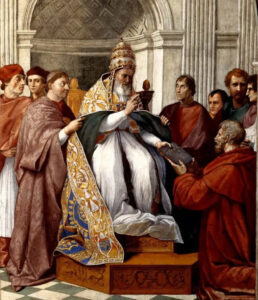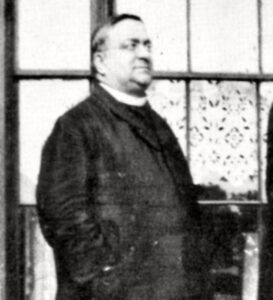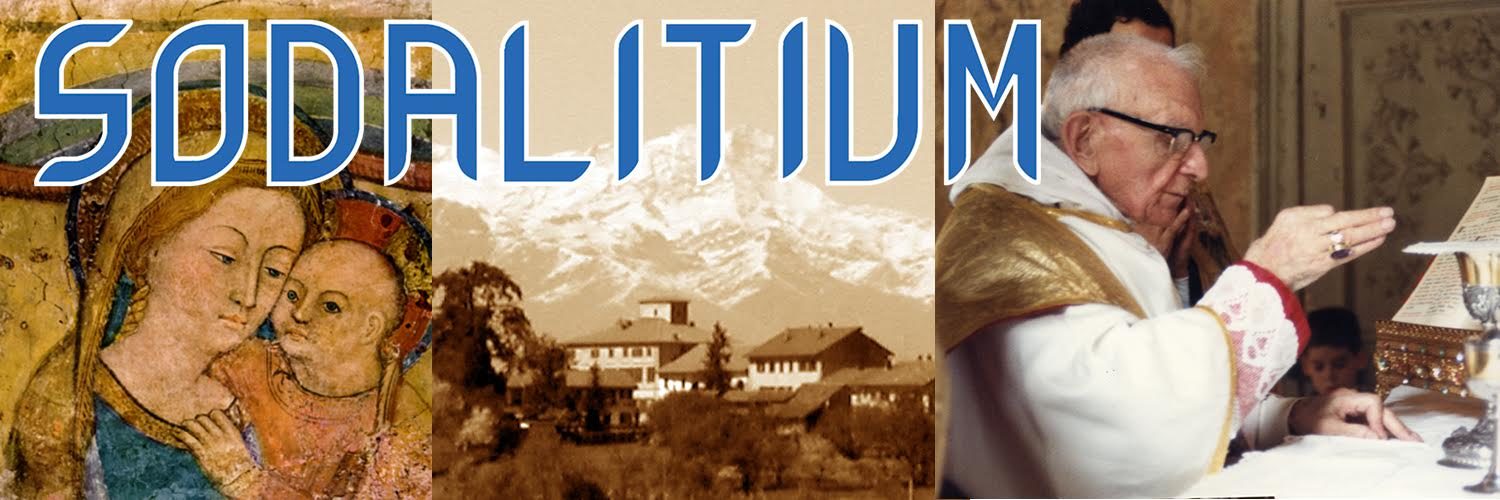On the feast of Saint Gregory I, we publish the beginning of the chapter dedicated to the figure of the great pontiff by Msgr. Umberto Benigni, in his Social History of the Church (vol. III). In this work, reprinted by the Centro Librario Sodalitium, this extract is followed by another 14 pages dedicated to the Pope.
The Gregorian cycle
The cycle of the three first Gregorys (Gregory the Great elected in 590, Gregory III died in 741) includes a fifty-year period that, while not leaving the Byzantine hegemony, is clearly different from the previous one by the fact of the Italian policy of the Popes.
Always faithful citizens of the “Roman” empire, and therefore of Byzantium, like their predecessors from the time of Pope Odoacer onwards, the pontiffs of the Gregorian cycle rose to a true political power, with which the Langobards on the one hand, and Byzantium on the other, had to deal more and more in a way they had never before. Popes entrusted with a political mission were frequently seen; but as we have already mentioned, the pontiffs sent by force and with bestial threats or reprisals by the Goth kings to Byzantium, do not really present the figure of a political power, in the usual sense of the word, but rather the prestige deriving from the apostolic succession. But the Langobard domination did not take long to persuade the Byzantine autocrat that the Justinian reconquest of Italy was a historical fact that would not be revived; so he had to content himself with preserving the shreds of it for as long as possible. The direct consequence of this state of affairs was that Rome and the Pope were increasingly removed from the Byzantine brutality that had oppressed the very person of the popes from Liberius to Vigilius.
The emperor usually had to content himself with the impertinences that he wrote or ordered to write to Gregory the Great and his successors when politics did not advise him to cover him with honours, as Justin I and his nephew Justinian had already done with John I.
The substratum of this changed situation was, as we have just said, the intervening Langobard domination which, on the one hand, reduced  Byzantine hegemony to nothing, and, on the other hand, never merging with the Italians, created for the latter a separate position, that of an increasingly distinct third entity, no longer dominated by Byzantium, not absorbed by the Langobards, always threatened by both, but now such that, by having a superior man in charge of it, it could open the way between the two enemies.
Byzantine hegemony to nothing, and, on the other hand, never merging with the Italians, created for the latter a separate position, that of an increasingly distinct third entity, no longer dominated by Byzantium, not absorbed by the Langobards, always threatened by both, but now such that, by having a superior man in charge of it, it could open the way between the two enemies.
And, at the providential moment, there came not a simply superior man, but a genius: Gregory the Great (the bold is editorial, ed.).
This authentic Roman nobleman came to the clericate from civil offices, like Ambrose. He was praetor in Rome at the time of Tiberius II. Absorbed by the sublime ideal of religion, which provided him with a true catholic mentality, that is, religiously universal, full of apostolic zeal, Gregory was truly the man worthy of being appointed successor to St Peter by common acclamation. In him, the supernatural truth of the apostolic sentence shines forth: piety is useful for everything, piety, it is understood, deep and enlightened. This pious man who dreamed of the quiet monastic life, who never intended to engage in politics, but only to fulfil his ministry of truth, justice and charity, was the only great politician of his time, taking the word ‘politician’ in the lofty historical sense that can best be attributed to it. Anti-Catholic historians have tendentiously said of him, that he founded the Roman papacy; that that bishop of Rome was the first Pope. The historical truth is that St Peter was the first pope; but it is also true that Gregory the Great stamped on the Christian world the largest papal footprint that had ever been seen until then and that, at least in a certain sense, would never be seen again in the future. His prodigious activity, of which his cosmopolitan correspondence was an instrument, held the threads of the entire Catholic world in his hand and made it turn constantly to Rome for every moral and material issue. As for Italy, Gregory was its true moral ruler; the Langobards themselves felt and treated him as such. When his epistolary correspondence lists his “military” letters, in which he orders the bishops of the Peninsula and the islands to arm the city militia, or to keep watch, or to exempt someone from sentry duty, and when he negotiates with the courts of Pavia and Byzantium to save the torn Italy, his figure as a “sovereign” eclipses that of the other crowned ones.
And amidst the nimbus of civil glory, the holy Pontiff lived all absorbed in his religious  mission. In him shines the word of Christ that no one should ever forget, from his Vicar to the last believer: Seek first the kingdom of God and his righteousness, and you will have all these things in addition.
mission. In him shines the word of Christ that no one should ever forget, from his Vicar to the last believer: Seek first the kingdom of God and his righteousness, and you will have all these things in addition.
Gregory, who lived and died convinced that he was, politically speaking, a citizen of the Roman Empire, and who wrote to his ‘lords’ the emperors of Constantinople as the most loyal subject, was the one who laid the then unseen foundations not only of the Papal State but of the political hegemony of the great mediaeval pontiffs. Between Gregory the Great and Gregory VII there is a huge difference in political demeanour, but this difference is much more due to the different environment than to the fundamental mentality of the two great Gregors. The latter is the logical evolution of the former.
Msgr. Umberto Benigni, Storia sociale della Chiesa, vol. III. La crisi della società antica (Dalla caduta alla rinascita dell’Impero Romano), Casa Editrice Vallardi, Milan 1922, pp. 152 – 154.
Centro Librario Sodalitium‘s reprint of the complete work, 5 volumes in 7 tomes, totaling 5000 pages: https://www.sodalitiumshop.it/prodotto/storia-sociale-della-chiesa-opera-completa/

